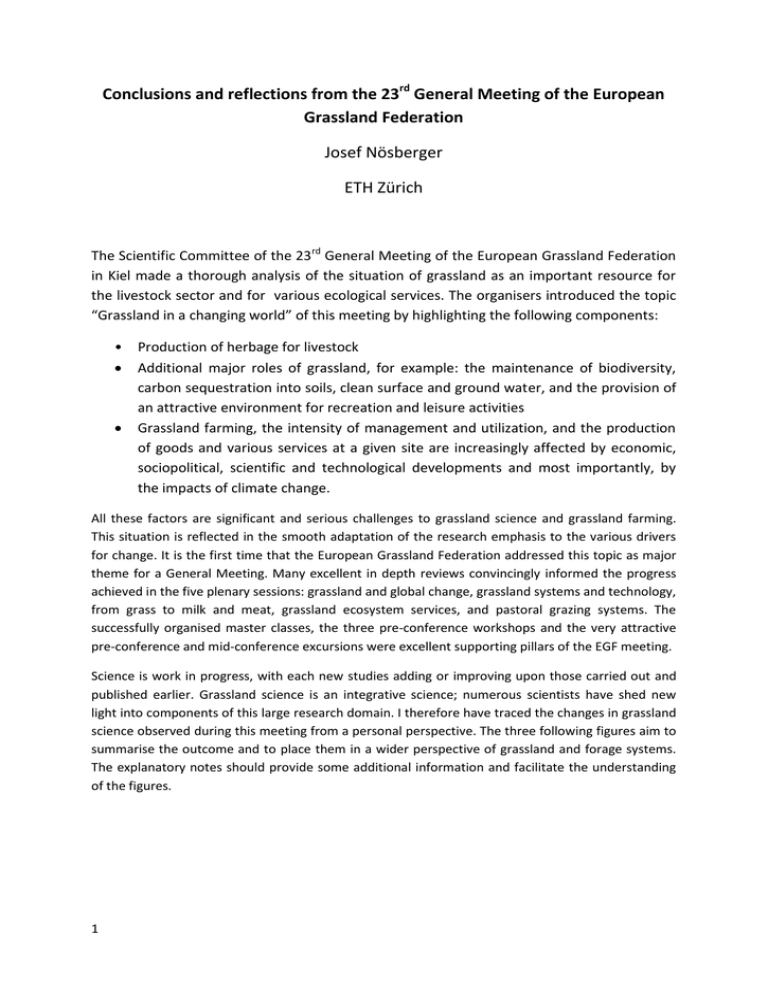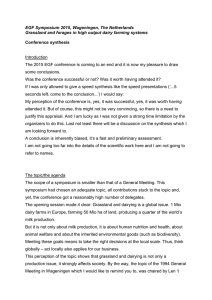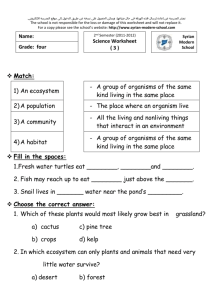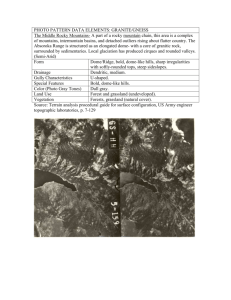Conclusions and reflections from the 23 General Meeting of the European
advertisement

Conclusions and reflections from the 23rd General Meeting of the European Grassland Federation Josef Nösberger ETH Zürich The Scientific Committee of the 23rd General Meeting of the European Grassland Federation in Kiel made a thorough analysis of the situation of grassland as an important resource for the livestock sector and for various ecological services. The organisers introduced the topic “Grassland in a changing world” of this meeting by highlighting the following components: • Production of herbage for livestock Additional major roles of grassland, for example: the maintenance of biodiversity, carbon sequestration into soils, clean surface and ground water, and the provision of an attractive environment for recreation and leisure activities Grassland farming, the intensity of management and utilization, and the production of goods and various services at a given site are increasingly affected by economic, sociopolitical, scientific and technological developments and most importantly, by the impacts of climate change. All these factors are significant and serious challenges to grassland science and grassland farming. This situation is reflected in the smooth adaptation of the research emphasis to the various drivers for change. It is the first time that the European Grassland Federation addressed this topic as major theme for a General Meeting. Many excellent in depth reviews convincingly informed the progress achieved in the five plenary sessions: grassland and global change, grassland systems and technology, from grass to milk and meat, grassland ecosystem services, and pastoral grazing systems. The successfully organised master classes, the three pre-conference workshops and the very attractive pre-conference and mid-conference excursions were excellent supporting pillars of the EGF meeting. Science is work in progress, with each new studies adding or improving upon those carried out and published earlier. Grassland science is an integrative science; numerous scientists have shed new light into components of this large research domain. I therefore have traced the changes in grassland science observed during this meeting from a personal perspective. The three following figures aim to summarise the outcome and to place them in a wider perspective of grassland and forage systems. The explanatory notes should provide some additional information and facilitate the understanding of the figures. 1 We have to consider the situation of grasslands in a global perspective as increasingly important, global food demand is growing and the availability of the needed resources for additional food production in the long term is associated with great uncertainties. Grassland in a Global Perspective Drivers and Effects • • • • • World food situation Politics Markets Globalisation Climate change Direct & indirect drivers of change Land use • Changes in land-use systems • Site-specific constraints • Milk • Meat, Wool • Ecosystem services Drivers of demand of the society Figure 1 The left box of Figure 1 lists the natural or human-induced drivers which directly or indirectly cause a change in land use and consequently also affect grassland systems. Important direct drivers include climate change, nutrient availability, land conversion leading to habitat change, and invasive species. Indirect drivers of change operate more diffusively by altering land use, including grassland systems. Indirect drivers of change are demographic, economic, sociopolitical, scientific and technological, and cultural. This is obvious when we consider that the dairy, beef and sheep sectors are highly dependent on policy interventions implemented as part of the EU Common Agricultural Policy (CAP). At present, financial support is still high and markets will be further deregulated in the future. Several challenges arise for policy-oriented research. What will be the competiveness of the dairy, beef and sheep sector in the future? This requires answers both in the short and long term within the European scenario. The land-use box in Fig. 1 refers to the changes in the land-use systems. Presentations at this EGF meeting clearly showed that the specialization of dairy farms in privileged areas is continuously increasing. Grassland is replaced by silage maize. However, the vast area of 2 marginal lands in Europe allows only extensive uses from the productivity perspective, although, the society no longer considers a one-sided focus on efficient production as being adequate. Grasslands are not only the main resource base for ruminants, the awareness of the society for the other benefits is rising. The Millennium Ecosystem Assessment (2005) concepts are very useful criteria to broaden the benefits of grassland output. These concepts link human well-being and ecosystems: the ecosystem services. Ecosystem services are the benefits people obtain from ecosystems. These include provisioning services such as food, drinking water; regulating services such as regulation of floods, drought, land degradation; supporting services such as biogeochemical cycles, soil formation; and cultural services such as recreational, aesthetic, spiritual and other nonmaterial benefits. A considerable amount of research is needed to understand the role of different components of managed grasslands in the provision of ecosystem services for human welfare. The actual experimental evidence about the effects of grassland management on ecosystem services is very thin. We do need more scientific facts about the ecological services of extensively managed grassland beyond biodiversity. Grassland science has to build the capacity for analyzing these interactions and also assist in providing a knowledge base for decisions. Components of Grassland Systems Challenges and Changes in Emphasis Semi-natural & sown grassland • Grassland & herd management • Revival of legumes • Grass intake • Resilience • Adaptation • Mitigation Milk & Meat • Efficiency • Cows of high genetic merit • Quality • Energy use • Green house gas • Mitigation • Authenticity • Traceability Future production systems • • • • • Biomethane Technology Efficiency Sustainability Ethics Ecosystem services • Genetic resource • Biodiversity • Evidence for other services ? • Farm level • Watershed level • Risks of scaling-up Evaluate • Why we do what we do? • Spatial and temporal scale • Road map for future directions • Figure 2 3 In Fig. 2 the row of arrows indicate the core components of actual and future grassland systems. The transformation of grass and forage to animal products represented one focus of grassland science and animal husbandry over many decades. This domain is continuously developing and aims to work out management options adapted to the changing economical conditions and regulations. However, grassland science is now challenged by new demands (e.g ecosystem services, biomethane) which request new production systems. “Evaluate” stands for an invitation to reconsider the current research activities in relation to the rapidly changing socio-economical and environmental conditions. The columns under each component list keywords which were rarely used in former EGF meetings; some reached a prominent position at this meeting, others were hardly addressed. This situation is reflecting the changes in emphasis and the knowledge gaps. The yellow marked keywords indicate research domains where the actual knowledge is still rudimentary. The presentations showed that grassland and herd management must develop site-adapted optimal combinations for the efficient use of resources. This paradigm leads to a revival of the roles of legumes, especially white clover, and of the importance of the herbage intake by the livestock. Resilience is the capacity of a system to absorb disturbances; a characteristic of increasing importance for farmers exposed to severe time and cost-constraints. Adaptation and mitigation indicate the processes to cope with the impacts of climate change, which may not all likely to be negative. An increase in mean temperature and changes in seasonal precipitation can be confidently expected. Adaptation strategies are only effective in the particular areas at which the strategies aim, for example the availability of more drought-tolerant species and cultivars for a specific site or region. One distinct difference between mitigation and adaptation policies is the scope of effectiveness. Mitigation policies that aim at reducing atmospheric concentration of greenhouse gases (for example carbon sequestration into the soil, making use of biological nitrogen fixation to reduce the need for mineral nitrogen fertilizer) will be effective in mitigating climate change at global level. The low-cost grass-based production systems will need to diversify and to adapt, but it is not envisaged that climate change will affect the profitability of these systems in a negative manner. The interest for deep rooting species such as lucerne and red clover could increase, because they allow the use of the water reserves in deeper soils layers. Accurate prediction of dry matter intake is central to the low cost formulation of lactating diets in cows, since most of the variation in total nutrient intake is related to differences in intake rather than digestibility. Forage factors can have a substantial influence on milk fat and protein concentrations, but also contribute to nutritive value (vitamins, fatty acids), sensory properties and physical characteristics of milk and milk products. 4 Much progress has been made in recent years in advancing our capabilities in the area of food authentication. Challenges clearly remain in applying authentication methodologies to food of animal origin because potential markers of geographical origin or production systems are influenced by the complexities of pre-slaughter diets available to animals and of the production systems themselves. Novel approaches are required to overcome these hurdle. From the perspective of future production systems in grasslands, biomethane production is attracting significant interest. The deployment of transport biofuels is significantly affected by policy in energy and agriculture. To be a viable alternative, a biofuel should provide a net energy gain, have environmental benefits, be economically competitive, and be producible in large quantities without reducing food supplies. Agricultural Research is Supported from the Findings in Different Systems citation index Ecologists Field experiments Physiologists Agronomists, breeders Molecular biologists Farmer New options Increasing complexity Eco-social construct Modelling Advisors Figure 3 Fig. 3 aims to show that agricultural research is supported from the findings in different conceptual systems encompassing plant communities, whole plants, tissues, organs, cells, membranes and genes. These systems are essentially structural, but implied in them are a enormous wide range of time scales and processes and interaction that are predominantly peculiar to each structural scale. It is informative to view them as a loop in which one can travel in any direction (adapted from Passioura, 2010). Clockwise flow denotes the search for functional significance (integration). The anticlockwise flow denotes the familiar search for a mechanistic understanding at finer and detailed scales (reductionism). The anticlockwise 5 flow essentially stops at the gene level. The science administrators expect from scientists working at finer scales (e. g. molecular biologists, physiologists) that they contribute to the citation index of their institution. As a consequence, short-term experiments which offer potentially more publications are prioritized and experiments with a longer time-span often do not receive adequate support from the research agencies. There is a temptation of scientists working at finer scale not only to reach recognition by their peers but also to show that the results of their work are useful, thus they are scaling up, at times to unacceptable levels. An essential feature of scaling up is that the higher level brings with it a range of constraints and interactions that affect operations at that level, but are generally unfamiliar to practitioners at lower levels. An often observed extrapolation from small plot experiments, e.g. for the species richnessproductivity, relationships cannot be considered as an evidential basis for a field situation. In small grassland plots physical competition for light, water, and nutrients is crucial in determining presence and growth of an individual species within a sward. Many experimental plots are too small to represent the community. Appropriate plot sizes and the consideration of realistic management manipulation are a prerequisite for ecological experiments to be considered as relevant for the grassland farmer. The grassland community should adopt a far more rigorous and critical attitude in the use of results from very small plots for the elaboration of management recommendations. Science based advice to farmers must be based on thorough field experiments with realistic management treatments and which consider also the economic implications for the farmer and on the operation on a whole-farm scale. Long-term experiments are urgently needed to assess the ecosystem services of grasslands – a core task of public research institutions which should be less under the dictate of the citation index. It will hardly be possible to convince policy makers about the ecological services of grassland unless it is based on sound scientific information; large gaps still remain in our knowledge. This challenging task is very complex and requests inter-disciplinary and international cooperation. Effective research is a result from a culture of a mutually stimulating dialogue between scientists working at different scales and from the interactions between field scientists and farmers. The final arbiters in the implementation of recommendations are the farmers. Problems are inherently multidisciplinary in nature. New methods are needed to deepen our insight. This meeting has shown that new methods developed in the field of genomics, stable isotopes and statistics which may become useful tools in grassland science. Owing to the complexity of grassland systems, and the complexity of interactions encompassing different spatial and temporal scales, sustainable management decisions demand a greater degree of support. A strong modeling effort is needed in order to provide advisors and farmers with quantified outcomes of specific management decisions. The presentations and discussions at this EGF Meeting offered an insight into the role that grassland science can play in providing the scientific understanding what is happening to the grassland systems in response to globalization and global changes. We have to rethink and adapt our grassland management practices to ensure sustainable provision of goods and 6 services in the future. These challenging tasks require the development of collaborative partnership to deal with complexities and uncertainties. EGF Meetings provide a sound forum to interact and to exchange knowledge between European partners and even beyond. Reference: Passioura, J. B., 2010. Scaling up: the essence of effective agricultural research. Functional Plant Biology, 37 (7), 585-591 7






